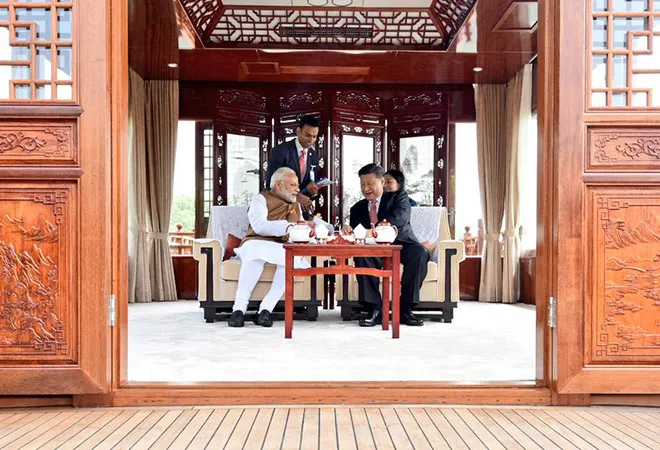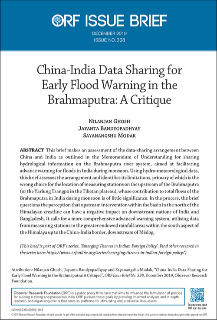There is a facile similarity being made out between the Modi-Xi summit in Wuhan and the repeat of the Rajiv Gandhi-Deng Xiaoping meeting of December 1988. The thirty years of history that have passed since the latter event make the Wuhan meeting very different.
It is true that both events come in the wake of face-offs that have gone well for India. In 1986-87 under Operation Falcon, the Indian Army for the first time looked at the PLA eye-to-eye and forced it to recognize that the balance of power on the border was no longer what had prevailed a decade before.
In 2017, the Indian Army intervened in Doklam to block a Chinese road-building project in territory disputed between China and Bhutan. In the end, given their adverse position, the Chinese backed off. The 1988 visit followed the 1986-87 crisis, and the 2018 visit is following the Doklam faceoff.
The result of the 1988 Rajiv Gandhi visit was that India agreed to set aside its demand that China settle the border issue before there could be a normalization of ties. Talks took place that resulted in two far reaching agreements in 1993 and 1996 that created an elaborate structure of confidence building that has ensured that despite occasional face-off the two sides have managed to maintain peace and tranquility along their disputed 4,000 km border.
Since then, of course, Sino-Indian relations have developed much greater complexity. For one, the two sides have major trade relations. Indeed, China is India’s main source of merchandise imports. In this period we have also seen the rise of China as a huge economic power with its GDP rising from $1 trillion in 2001 to $ 14 trillion today. In the same period, its foreign exchange reserves have risen from $220 billion to a huge $ 3 trillion.
More important, China has become economically and diplomatically active in a region we saw as our sphere of interest—the South Asian neighbourhood and the Indian Ocean region. India has watched this uneasily and sought to reach out to the US to balance China. But the US has its own complex relationship with Beijing and is not likely to resolve our dilemma in the South Asian-Indian Ocean region.
In the run up to the elections, Modi had attacked the UPA for allowing China to get away with its border transgressions. In 2014 and 2015, Modi sought to work with China. But subsequently, since 2016, the Modi government took a hard line on China. On one hand it encouraged the Dalai Lama and the Tibetan government-in-exile and on the other it publicly attacked China for not backing India’s membership in the Nuclear Supplier’s Group and designating Masood Azhar as a terrorist under the United Nation’s 1267 Committee. It also led a campaign against XI Jinping’s Belt and Road Initiative.
But the 2017 Doklam crisis brought home to the government the risks of an unrelentingly tough stand. It had led to China building up its forces along the Line of Actual Control and there were worries that a face-off between the two countries could derail Modi’s re-election campaign. So, India decided to backtrack and reach out to China. Beijing was only too happy to oblige since it is in the midst of a trade war with the US, with the Trump Administration threatening to attack China’s efforts to develop an autonomous industrial base.
In this context the question to be asked is: What has the 2018 visit yielded? Though officials had played down the possibility of any specific outcome from the Modi-Xi informal summit in Wuhan on Friday and Saturday, there have been some specific outcomes as outlined by the Foreign Secretary Vijay Gokhale at a press briefing.
An important outcome is their decision to provide “strategic guidance” to their respective militaries to keep peace along the Sino-Indian border. This would involve enhanced official level meetings to build trust and understanding and the implementation of the existing confidence building agreements and institutional mechanisms to resolve problems in the border areas.
Additionally, it was noted that the two sides also recognize the common threat posed by terrorism and the need to oppose it in all its forms and manifestations. India and China have decided to cooperate in joint projects in Afghanistan and we could also see possible collaboration in third countries such as Nepal or Bangladesh.
The leaders endorsed the work of the Special Representatives (NSA Ajit Doval from the Indian side and State Councillor Yang jichei and now Wang Yi from the Chinese) to find a fair, reasonable and mutual settlement to the dispute. Gokhale told the media that the two leaders felt that the two countries were mature enough to settle their differences through peaceful discussions and keeping in mind the larger context of their relationship. Also the two should bear in mind the need to “respect each other’s sensitivities, concerns and aspirations.”
This last phrase is important because this is what the Wuhan summit is all about. It is similar to the one used in the wake of the 20th meeting of the Special Representatives in December 2017, the meeting which probably set the stage for the Wuhan summit.
It would be surprising if we see a sudden change in Chinese behavior either on the border on in relation to Pakistan. But the aim of the summit was not that. It was to work out the terms of peaceful co-existence of the two Asian giants. These are not spelt out in declarations, but implemented in practice. It is through such informal summits where the two leaderships get to know each other and get a better understanding of their motives and policies that the business of international relations is done.
This commentary originally appeared in Greater Kashmir.
The views expressed above belong to the author(s). ORF research and analyses now available on Telegram! Click here to access our curated content — blogs, longforms and interviews.




 PREV
PREV


